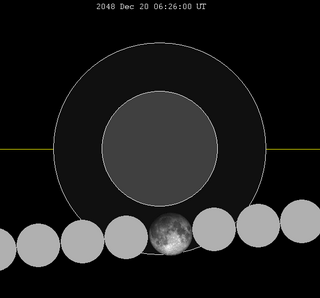| Penumbral eclipse | |||||||||
 | |||||||||
| Date | 3 March 2045 | ||||||||
|---|---|---|---|---|---|---|---|---|---|
| Gamma | −1.0274 | ||||||||
| Magnitude | 0.9623 [1] | ||||||||
| Saros cycle | 143 (19 of 72 [2] ) | ||||||||
| Penumbral | 243 minutes 57 seconds | ||||||||
| |||||||||
A penumbral lunar eclipse will take place on March 3, 2045.
| Penumbral eclipse | |||||||||
 | |||||||||
| Date | 3 March 2045 | ||||||||
|---|---|---|---|---|---|---|---|---|---|
| Gamma | −1.0274 | ||||||||
| Magnitude | 0.9623 [1] | ||||||||
| Saros cycle | 143 (19 of 72 [2] ) | ||||||||
| Penumbral | 243 minutes 57 seconds | ||||||||
| |||||||||
A penumbral lunar eclipse will take place on March 3, 2045.
| Descending node | Ascending node | |||||
|---|---|---|---|---|---|---|
| Saros | Date Viewing | Type Chart | Saros | Date Viewing | Type Chart | |
| 113 | 2042 Apr 05  | Penumbral | 118 | 2042 Sep 29  | Penumbral | |
| 123 | 2043 Mar 25  | Total | 128 | 2043 Sep 19  | Total | |
| 133 | 2044 Mar 13  | Total | 138 | 2044 Sep 07  | Total | |
| 143 | 2045 Mar 03  | Penumbral | 148 | 2045 Aug 27  | Penumbral | |
| Last set | 2041 May 16 | Last set | 2042 Nov 08 | |||
| Next set | 2046 Jan 22 | Next set | 2046 Jul 18 | |||
The Metonic cycle repeats nearly exactly every 19 years and represents a Saros cycle plus one lunar year. Because it occurs on the same calendar date, the Earth's shadow will be in nearly the same location relative to the background stars.
|
|
 |  |
A lunar eclipse will be preceded and followed by solar eclipses by 9 years and 5.5 days (a half saros). [3] This lunar eclipse is related to two partial solar eclipses of Solar Saros 150.
| February 27, 2036 | March 9, 2054 |
|---|---|
 |  |

A total lunar eclipse will take place on July 7, 2047. It will last 1 hour 40 minutes and 49 seconds and will plunge the full Moon into deep darkness, as it passes right through the centre of the Earth's umbral shadow. While the visual effect of a total eclipse is variable, the Moon may be stained a deep orange or red colour at maximum eclipse. This will be a great spectacle for everyone who sees it. The partial eclipse will last for 3 hours and 39 minutes in total.

A partial lunar eclipse took place on Saturday, December 21, 1991, the last of four lunar eclipses in 1991. The moon grazed the northern edge of the umbral shadow. It occurred near perigee, and as described, such event was known as a supermoon.
A penumbral lunar eclipse took place on Thursday, March 3, 1988, the first of two lunar eclipses in 1988, the second being on August 27, 1988. Earlier sources compute this as a 0.3% partial eclipse lasting under 14 minutes, and newest calculations list it as a penumbral eclipse that never enters the umbral shadow. In a rare total penumbral eclipse, the entire Moon was partially shaded by the Earth, and the shading across the Moon should have been quite visible at maximum eclipse. The penumbral phase lasted for 4 hours, 53 minutes and 50.6 seconds in all, though for most of it, the eclipse was extremely difficult or impossible to see. The Moon was 2.2 days after apogee, making it 6.1% smaller than average.

A penumbral lunar eclipse took place on Thursday, June 27, 1991, the second of four lunar eclipses in 1991. The moon entered the Earth's penumbra for about 3 hours, and was difficult to see. This lunar eclipse is the predecessor of the Solar eclipse of July 11, 1991.

A penumbral lunar eclipse will take place on Tuesday, August 17, 2027. It will cause a subtle dimming as 54.56% of the Moon will cross within Earth's penumbral shadow.
A partial lunar eclipse will take place on November 8, 2041.

A penumbral lunar eclipse will take place on June 15, 2049.

A total lunar eclipse will take place on January 1, 2048. It will be the first recorded lunar eclipse to be visible on New Year's Day for nearly all of Earth's timezones. The next such eclipse will occur in 2094.

A partial lunar eclipse will take place on January 22, 2046.

A total lunar eclipse will take place on September 19, 2043.

A total lunar eclipse will take place on September 7, 2044. It will be the first total eclipse in Lunar Saros 138.

A total lunar eclipse will take place on March 13, 2044.

A total lunar eclipse will take place on March 25, 2043.

A partial lunar eclipse will take place on July 18, 2046.

A penumbral lunar eclipse will take place on December 20, 2048.

A partial lunar eclipse will take place on June 26, 2048. The Moon will be strikingly shadowed in this deep partial eclipse lasting 2 hours and 39 minutes, with 63.88% of the Moon in darkness at maximum.

A total lunar eclipse will take place on January 12, 2047.

A penumbral lunar eclipse will take place on May 17, 2049.

A total lunar eclipse will take place on April 26, 2051.

A total lunar eclipse will take place on October 30, 2050.